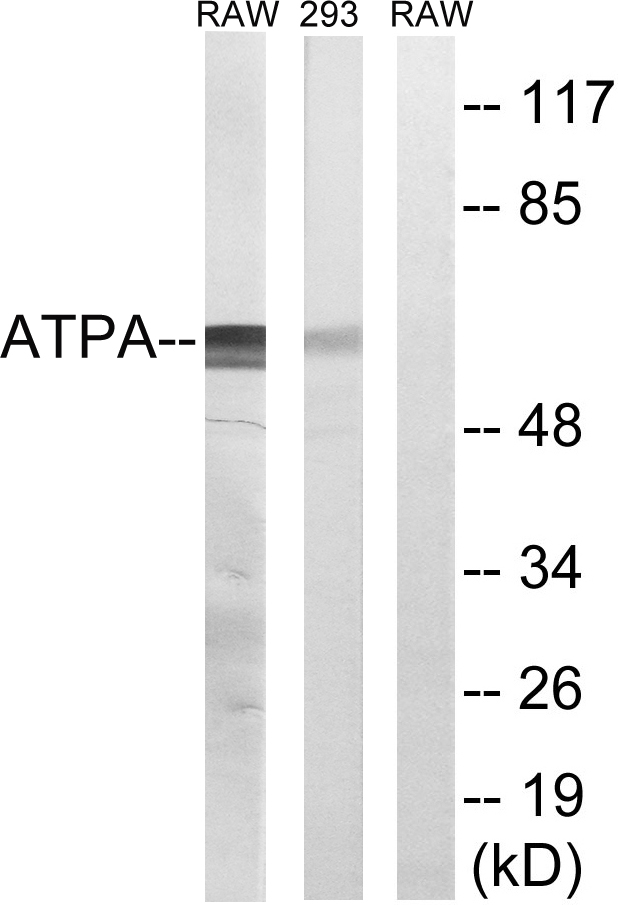ATP5A1 antibody [C2C3], C-term
GTX101741
ApplicationsImmunoFluorescence, Western Blot, ImmunoCytoChemistry, ImmunoHistoChemistry, ImmunoHistoChemistry Frozen, ImmunoHistoChemistry Paraffin
Product group Antibodies
TargetATP5F1A
Overview
- SupplierGeneTex
- Product NameATP5A1 antibody [C2C3], C-term
- Delivery Days Customer9
- Application Supplier NoteWB: 1:500-1:3000. ICC/IF: 1:100-1:1000. IHC-P: 1:100-1:1000. IHC-Fr: 1:100-1:1000. *Optimal dilutions/concentrations should be determined by the researcher.Not tested in other applications.
- ApplicationsImmunoFluorescence, Western Blot, ImmunoCytoChemistry, ImmunoHistoChemistry, ImmunoHistoChemistry Frozen, ImmunoHistoChemistry Paraffin
- CertificationResearch Use Only
- ClonalityPolyclonal
- Concentration0.66 mg/ml
- ConjugateUnconjugated
- Gene ID498
- Target nameATP5F1A
- Target descriptionATP synthase F1 subunit alpha
- Target synonymsATP5A, ATP5A1, ATP5AL2, ATPM, COXPD22, HEL-S-123m, MC5DN4, MC5DN4A, MC5DN4B, MOM2, OMR, ORM, hATP1, ATP synthase F(1) complex subunit alpha, mitochondrial, ATP synthase alpha chain, mitochondrial, ATP synthase, H+ transporting, mitochondrial F1 complex, alpha subunit 1, cardiac muscle, ATP sythase (F1-ATPase) alpha subunit, epididymis secretory sperm binding protein Li 123m, mitochondrial ATP synthetase, oligomycin-resistant
- HostRabbit
- IsotypeIgG
- Protein IDP25705
- Protein NameATP synthase F(1) complex subunit alpha, mitochondrial
- Scientific DescriptionThis gene encodes a subunit of mitochondrial ATP synthase. Mitochondrial ATP synthase catalyzes ATP synthesis, using an electrochemical gradient of protons across the inner membrane during oxidative phosphorylation. ATP synthase is composed of two linked multi-subunit complexes: the soluble catalytic core, F1, and the membrane-spanning component, Fo, comprising the proton channel. The catalytic portion of mitochondrial ATP synthase consists of 5 different subunits (alpha, beta, gamma, delta, and epsilon) assembled with a stoichiometry of 3 alpha, 3 beta, and a single representative of the other 3. The proton channel consists of three main subunits (a, b, c). This gene encodes the alpha subunit of the catalytic core. Alternatively spliced transcript variants encoding the same protein have been identified. Pseudogenes of this gene are located on chromosomes 9, 2, and 16. [provided by RefSeq]
- Storage Instruction-20°C or -80°C,2°C to 8°C
- UNSPSC12352203
References
- Zhao M, Wei H, Li C, et al. Gut microbiota production of trimethyl-5-aminovaleric acid reduces fatty acid oxidation and accelerates cardiac hypertrophy. Nat Commun. 2022,13(1):1757. doi: 10.1038/s41467-022-29060-7Read this paper
- Suzuki T, Terada N, Higashiyama S, et al. Non-microtubule tubulin-based backbone and subordinate components of postsynaptic density lattices. Life Sci Alliance. 2021,4(7). doi: 10.26508/lsa.202000945Read this paper
- Lee SO, Jin UH, Kang JH, et al. The orphan nuclear receptor NR4A1 (Nur77) regulates oxidative and endoplasmic reticulum stress in pancreatic cancer cells. Mol Cancer Res. 2014,12(4):527-538. doi: 10.1158/1541-7786.MCR-13-0567Read this paper







